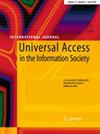Use case modeling in a research setting of developing an innovative pilgrimage support system
IF 2.7
4区 计算机科学
Q3 COMPUTER SCIENCE, CYBERNETICS
引用次数: 0
Abstract
Abstract With so much confusion around use case modeling, software developers may be reluctant to apply it. However, use cases are easy to apply and have great benefits even in research settings with nonprofessional software developers involved. We report on our experience on this within an innovative tourist information system developed in a research setting of an ongoing Horizon 2020 project named Promotion of Rural Museums and Heritage Sites in the Vicinity of European Pilgrimage Routes (rurAllure). The resulting use case model comprises forty use cases supported by class diagrams, use case diagrams, sequence diagrams, as well as by the domain model and dictionary. Three quarters of use cases have been implemented at least to some extent. Writing use cases provoked intense communication, which helped consolidate the system architecture. The use cases helped validate and better understand the GUI form wireframes designed beforehand and get quickly to a consistent implementation of the system that can be experimented with further in different ways. Finally, the forthcoming extensive system and user experience testing will be guided by the use case model. The paper also exposes the domain model and dictionary along with selected use cases and the hierarchy of user and system actors, which may be useful as such or as a stimulus for the development of other innovative tourist information systems.以开发创新朝圣支持系统为研究背景的用例建模
由于围绕用例建模有如此多的困惑,软件开发人员可能不愿意应用它。然而,用例很容易应用,甚至在非专业软件开发人员参与的研究环境中也有很大的好处。我们在一个创新的旅游信息系统中报告我们在这方面的经验,该系统是在正在进行的“地平线2020”项目的研究环境中开发的,该项目名为“促进欧洲朝圣路线附近的乡村博物馆和遗产遗址”(rurAllure)。最终的用例模型由40个用例组成,这些用例由类图、用例图、序列图以及领域模型和字典支持。四分之三的用例至少在某种程度上已经实现了。编写用例引发了激烈的沟通,这有助于巩固系统架构。用例有助于验证和更好地理解预先设计的GUI表单线框图,并快速获得系统的一致实现,可以以不同的方式进一步试验。最后,即将进行的广泛的系统和用户体验测试将由用例模型指导。本文还揭示了领域模型和词典,以及选定的用例和用户和系统参与者的层次结构,这可能对开发其他创新的旅游信息系统很有用。
本文章由计算机程序翻译,如有差异,请以英文原文为准。
求助全文
约1分钟内获得全文
求助全文
来源期刊

Universal Access in the Information Society
COMPUTER SCIENCE, CYBERNETICS-
CiteScore
6.10
自引率
16.70%
发文量
81
审稿时长
>12 weeks
期刊介绍:
Universal Access in the Information Society (UAIS) is an international, interdisciplinary refereed journal that solicits original research contributions addressing the accessibility, usability, and, ultimately, acceptability of Information Society Technologies by anyone, anywhere, at anytime, and through any media and device. Universal access refers to the conscious and systematic effort to proactively apply principles, methods and tools of universal design order to develop Information Society Technologies that are accessible and usable by all citizens, including the very young and the elderly and people with different types of disabilities, thus avoiding the need for a posteriori adaptations or specialized design. The journal''s unique focus is on theoretical, methodological, and empirical research, of both technological and non-technological nature, that addresses equitable access and active participation of potentially all citizens in the information society.
 求助内容:
求助内容: 应助结果提醒方式:
应助结果提醒方式:


